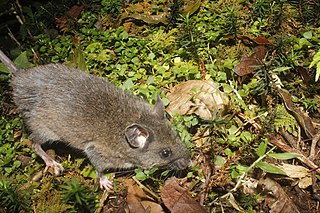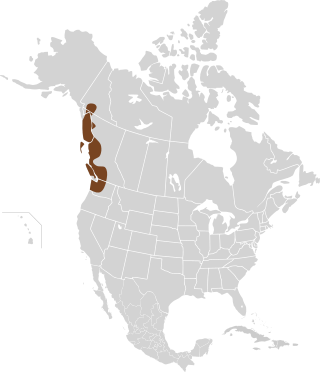
Peromyscus is a genus of rodents. They are commonly referred to as deer mice or deermice, not to be confused with the chevrotain or "mouse deer". They are New World mice only distantly related to the common house and laboratory mouse, Mus musculus. From this relative, Peromyscus species are distinguished by relatively larger eyes, and also often two-tone coloring, with darker colors over the dorsum (back), and white abdominal and limb hair-coloring. In reference to the coloring, the word Peromyscus comes from Greek words meaning "booted mouse". They are also accomplished jumpers and runners by comparison to house mice, and their common name of "deer mouse" is in reference to this agility.
Eva's desert mouse is a species of rodent in the genus Peromyscus of the family Cricetidae found only in the Baja California peninsula of Mexico.
The blackish deer mouse is a species of rodent in the family Cricetidae found only in Mexico, and is relatively poorly studied.
The big deer mouse is a species of rodent in the family Cricetidae. It is found only in Guatemala.
Osgood's mouse is a species of rodent in the family Cricetidae. It is found only in Mexico. Its name references Wilfred Hudson Osgood.
The Guatemalan deer mouse is a species of rodent in the family Cricetidae. It is found in Guatemala and Mexico.
The naked-eared deer mouse is a species of rodent in the family Cricetidae. It is found in El Salvador, Guatemala, Honduras, Mexico, and Nicaragua.
The Maya mouse is a species of rodent in the family Cricetidae. It is found only in Guatemala.
The brown deer mouse is a species of rodent in the family Cricetidae found only in Mexico.
The Puebla deer mouse is a species of rodent in the family Cricetidae. Only two specimens are known, both from Puebla, Mexico, with the last collected in 1947. It is therefore possible that the species is now extinct, although it is currently listed as Critically Endangered by the IUCN.

The black-wristed deer mouse is a species of rodent in the family Cricetidae. It is found in the Sierras de Zempoaltépec, Juárez, and Mazteca, sub-ranges of the Sierra Madre de Oaxaca in southern Mexico, between 1,500 and 2,500 meters elevation.
The plateau mouse is a species of rodent in the family Cricetidae. It is found only in Mexico.
The black-tailed mouse is a species of rodent in the family Cricetidae endemic to Mexico.
The mesquite mouse is a species of rodent in the family Cricetidae found in Mexico and in Arizona in the United States.

The Mexican deer mouse is a species of forest-dwelling rodent in the family Cricetidae. It is found in southern Mexico and throughout much of Central America.
The northern rock mouse is a species of rodent in the family Cricetidae. It is found in Mexico and the United States.

The northwestern deer mouse or Keen's mouse is a species of rodent in the family Cricetidae. It is found in British Columbia in Canada and in Alaska and Washington in the United States. It was named after the Rev. John Henry Keen in 1894.
The Chihuahuan mouse is a species of rodent in the family Cricetidae.
The gleaning mouse is a species of rodent in the family Cricetidae. It is found only in Mexico.
The Chiapan deer mouse is a species of rodent in the family Cricetidae. It is found only in Mexico.





